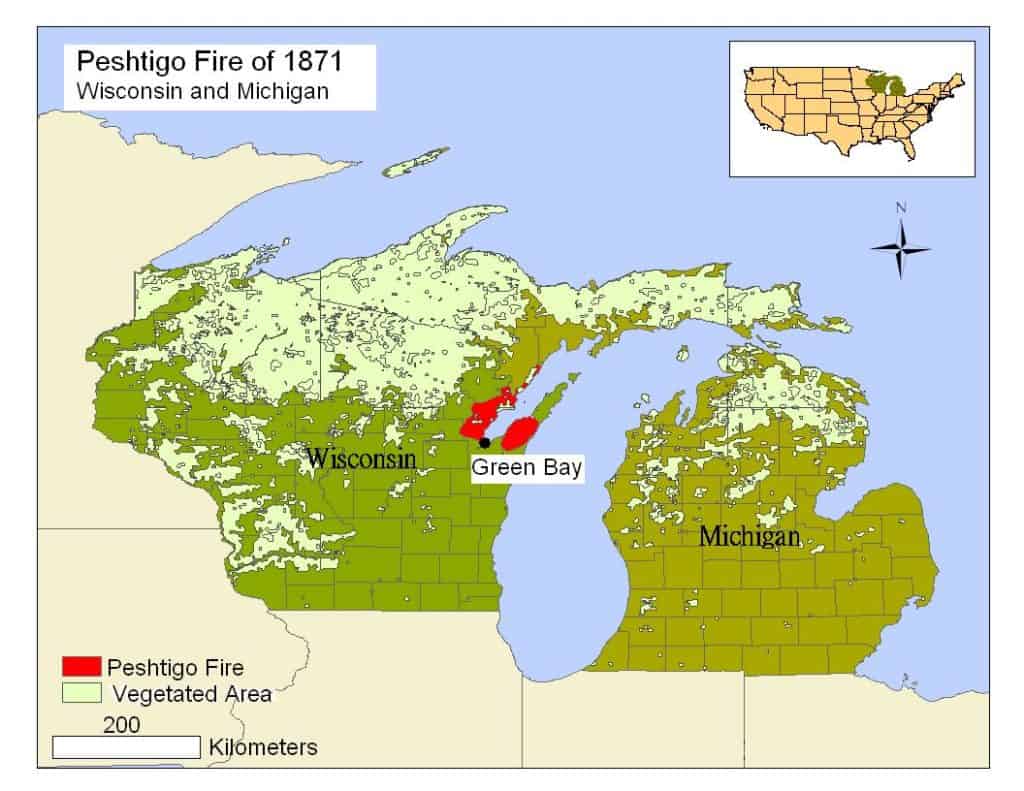When historians discuss a terrible fire that killed hundreds of people on October 8, 1871, most people assume they are referring to the Great Chicago Fire which rampaged through the Windy City and killed around 300 people. Yet incredibly, an even more devastating fire occurred on the same day just 250 miles away in Peshtigo, Wisconsin and had been largely forgotten by history.
While the fire in Chicago left 100,000 people homeless, it was confined to an area of just over nine square kilometers. The fire in Peshtigo killed an estimated 2,400 people and spread across an area of 4,900 square kilometers. Even more remarkably, there were also fires in Holland and Manistee and another at Port Huron in Michigan on the same day. The spate of fires has led historians to believe there was a mutual cause because it is very odd for so many huge blazes to take place at nearly the same time in a relatively small geographical area.
A Disaster Waiting to Happen
In the middle of the 19th century, it was normal for companies to set small fires to get rid of forest land and clear a path for railroad construction and farming. Peshtigo was a lumber and sawmill town, and William Ogden was the main businessman in the region. The summer of 1871 was unusually hot and dry in the northern Midwest. Despite the obvious risks, settlers continued to adopt the traditional burning of a land method to create new farmland. It was a recipe for disaster, and there had already been warnings with significant fires in several locations from Canada to Iowa within the previous month.
A large number of Midwestern towns were susceptible to fires and Peshtigo was especially prone given its dependence on lumber. In fact, practically every building in the town was made with a timber frame. To make matters worse, the most important bridge in and out of Peshtigo was made from lumber, and the roads to and from the town were covered in sawdust. As a result, if a fire started, it would be incredibly difficult to flee.

What Happened?
Clearly, the residents of Peshtigo were at least concerned about the prospect of fire because, on September 23, they stockpiled a huge supply of water. However, they were completely unprepared for what happened on October 8. The previous day, a fire began in an unknown spot in the Wisconsin forest. The first place to feel the wrath of the fire was the small village of Sugar Bush where every resident died.
A combination of dry land and high winds turned the fire into a raging inferno that spread with terrifying speed. At one point, the fire was over 200 feet high, and it apparently jumped several miles over Green Bay’s waters; most historians say that never happened and was simply a case of another fire happening at the same time. The fire almost became its own wind system, and the blazing tornado made its way to Peshtigo at a speed that caught the residents by surprise. The fire reached 2,000 degrees Fahrenheit and caused trees to explode along its path.

When the fire reached the town, the inhabitants had no chance. According to sources, 200 people died in a single tavern, and some of the residents who fled simply burst into flames such were the intensity of the blaze. A number of people fled to the local river but were unable to escape and drowned. Archaeologists found evidence that three people who tried to hide in a water tank were boiled to death because the fire heated the water so much.
A mass grave was found containing up to 350 people; they were buried together because the fire burned them beyond recognition. Despite the impact of the blaze, it became a mere footnote in history as the Great Fire of Chicago happened on the same day. Also, no one has ever found the exact location where the fire started.

